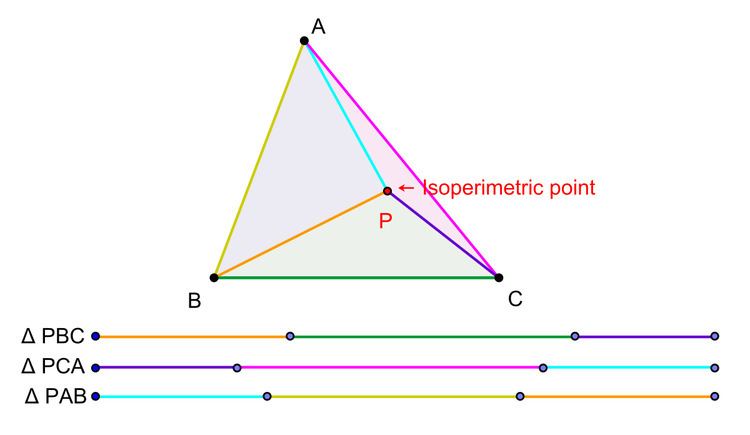 | ||
In geometry, the isoperimetric point is a special point associated with a plane triangle. The term was originally introduced by G.R. Veldkamp in a paper published in the American Mathematical Monthly in 1985 to denote a point P in the plane of a triangle ABC having the property that the triangles PBC, PCA and PAB have isoperimeters, that is, having the property that
Contents
- Existence of isoperimetric point in the sense of Veldkamp
- Properties
- Isoperimetric points and Soddy circles
- References
Isoperimetric points in the sense of Veldkamp exist only for triangles satisfying certain conditions. The isoperimetric point of triangle ABC in the sense of Veldkamp, if it exists, has the following trilinear coordinates.
( sec ( A/2 ) cos ( B/2 ) cos ( C/2 ) − 1 , sec ( B/2 ) cos ( C/2 ) cos ( A/2 ) − 1 , sec ( C/2 ) cos ( A/2 ) cos ( B/2 ) − 1 )Given any triangle ABC one can associate with it a point P having trilinear coordinates as given above. This point is a triangle center and in Clark Kimberling's Encyclopedia of Triangle Centers (ETC) it is called the isoperimetric point of the triangle ABC. It is designated as the triangle center X(175). The point X(175) need not be an isoperimetric point of triangle ABC in the sense of Veldkamp. However, if isoperimetric point of triangle ABC in the sense of Veldkamp exists, then it would be identical to the point X(175).
The point P with the property that the triangles PBC, PCA and PAB have equal perimeters has been studied as early as 1890 in an article by Emile Lemoine.
Existence of isoperimetric point in the sense of Veldkamp
Let ABC be any triangle. Let the sidelengths of this triangle be a, b, and c. Let its circumradius be R and inradius be r. The necessary and sufficient condition for the existence of an isoperimetric point in the sense of Veldkamp can be stated as follows.
The triangle ABC has an isoperimetric point in the sense of Veldkamp if and only if a + b + c > 4R + r.For all acute angled triangles ABC we have a + b + c > 4R + r, and so all acute angled triangles have isoperimetric points in the sense of Veldkamp.
Properties
Let P denote the triangle center X(175) of the triangle ABC.
Isoperimetric points and Soddy circles
Given a triangle ABC one can draw circles in the plane of triangle ABC with centers at A, B, and C such that they are tangent to each other externally. In general, one can draw two new circles such that each of them is tangential to the three circles with A, B, C as centers. (One of the circles may degenerate into a straight line.) These circles are the Soddy circles of the triangle ABC. The circle with the smaller radius is the inner Soddy circle and its center is called the inner Soddy point or inner Soddy center of triangle ABC. The circle with the larger radius is the outer Soddy circle and its center is called the outer Soddy point or outer Soddy center of triangle ABC.
The triangle center X(175), the isoperimetric point in the sense of Kimberling, is the outer Soddy point of triangle ABC.
